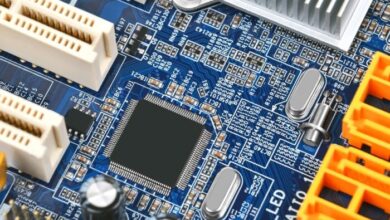
Developing IoT and Embedded Applications the Efficient Way
Developing IoT and embedded applications the efficient way requires a multifaceted approach, balancing performance, power consumption, and security. This isn’t just about writing code; it’s about carefully selecting hardware, optimizing software, and implementing robust power management strategies. From choosing the right microcontroller architecture to implementing secure boot processes, every decision impacts the efficiency and longevity of your IoT project.
This post dives deep into the key aspects of building efficient, reliable, and secure IoT solutions.
We’ll explore the crucial steps involved, from initial hardware selection and software design to deployment and ongoing maintenance. We’ll examine different microcontroller architectures, programming languages, and power management techniques, providing practical advice and code examples along the way. We’ll also cover essential security considerations and robust testing methodologies to ensure your IoT application is not only efficient but also secure and reliable.
Hardware Selection for Efficient IoT Development

Choosing the right hardware is paramount for building efficient and cost-effective IoT applications. The balance between processing power, memory, power consumption, and cost significantly impacts the overall design and longevity of your project. This section delves into the key considerations for selecting hardware components, focusing on microcontrollers and the trade-offs involved in module selection versus custom design.
Microcontroller Architectures: ARM Cortex-M vs. RISC-V
The choice between ARM Cortex-M and RISC-V architectures depends heavily on the specific application requirements. ARM Cortex-M processors are mature, widely supported, and boast a vast ecosystem of tools and peripherals. RISC-V, on the other hand, is an open-source instruction set architecture, offering greater flexibility and potential for customization, but with a slightly less mature ecosystem.
Microcontroller Comparison
The following table compares three popular microcontrollers, highlighting their power consumption, processing power, and memory capacity. These are approximate values and can vary based on operating conditions and specific microcontroller variants.
| Microcontroller | Power Consumption (typical) | Processing Power (MHz) | Flash Memory (KB) |
|---|---|---|---|
| STM32L476 (ARM Cortex-M4) | ~10 µA (sleep) to ~100 mA (peak) | 80 | 1024 |
| ESP32 (Tensilica Xtensa LX6) | ~5 µA (sleep) to ~200 mA (peak) | 240 | 4 MB (PSRAM) |
| GD32VF103 (RISC-V) | ~10 µA (sleep) to ~80 mA (peak) | 72 | 512 |
Bill of Materials (BOM) for a Low-Power Sensor Node
This BOM Artikels the components for a simple, low-power sensor node designed for long battery life. The choices prioritize low-power consumption and readily available components.
| Component | Description | Justification for Efficiency |
|---|---|---|
| Microcontroller | STM32L011 (ARM Cortex-M0+) | Ultra-low power consumption, suitable for battery-powered applications. |
| Sensor (e.g., Temperature) | TMP36 | Low power, analog output, simplifies circuitry. |
| Radio Module | nRF24L01+ | Low power, widely supported, suitable for short-range communication. |
| Power Supply | 3.3V Coin Cell Battery (e.g., CR2032) | Compact and provides sufficient power for long periods of low-power operation. |
| Passive Components | Resistors, Capacitors | Standard components chosen for minimizing power loss. |
Off-the-Shelf Modules vs. Custom Hardware Design
The decision between using off-the-shelf modules and designing custom hardware involves several trade-offs. Off-the-shelf modules offer convenience, faster development time, and often lower initial costs. However, they may lack flexibility, consume more power than a custom-designed solution, and may not perfectly meet the specific requirements of an application. Custom hardware design allows for optimization of power consumption and component selection, leading to potentially longer battery life and smaller form factors.
However, it requires more expertise, longer development time, and potentially higher initial costs. The optimal choice depends on factors such as project budget, time constraints, and the specific application needs. For example, a mass-produced IoT device might benefit from off-the-shelf modules, while a specialized application requiring extremely low power might necessitate a custom design.
Efficient Embedded Software Development Practices: Developing Iot And Embedded Applications The Efficient Way
Developing efficient embedded software for IoT applications requires a careful balance of resource management, code optimization, and real-time capabilities. Choosing the right tools and techniques from the outset is crucial for creating robust and reliable systems that meet performance requirements while minimizing power consumption and cost. This section delves into key practices for achieving this balance.
Real-Time Operating System (RTOS) Task Scheduling
Creating a robust task scheduler is fundamental for any RTOS-based IoT application. The scheduler determines which task runs when, ensuring timely execution of critical functions. A well-designed scheduler efficiently manages resources and prevents task starvation. Prioritization is key; tasks with stringent timing constraints (like sensor data acquisition) need higher priority than less critical tasks (like data logging).
A common approach involves a priority-based preemptive scheduler. This means that a higher-priority task will interrupt a lower-priority task if it becomes ready to run.
- Define Tasks and Priorities: Each task within the application should be clearly defined, specifying its function, execution frequency, and priority level. For example, a task responsible for processing sensor data might have a higher priority than a task that updates a display.
- Implement a Priority Queue: A priority queue data structure is used to store ready-to-run tasks, ordered by priority. Tasks are added to the queue when they become ready and removed when selected for execution.
- Context Switching Mechanism: A context switch mechanism is essential to save and restore the state of a task when it’s preempted by a higher-priority task. This involves saving the processor registers, program counter, and other relevant information.
- Timer Interrupts: Periodic timer interrupts are used to trigger the scheduler’s execution. The scheduler checks the priority queue and selects the highest-priority ready task to run.
- Resource Management: The scheduler should handle resource allocation and contention, preventing deadlocks and ensuring fair access to shared resources among tasks.
Programming Language Selection for Embedded Systems, Developing iot and embedded applications the efficient way
The choice of programming language significantly impacts code size, execution speed, and memory management in embedded systems. C, C++, and Rust are popular choices, each with its strengths and weaknesses.
| Language | Advantages | Disadvantages |
|---|---|---|
| C | Excellent control over hardware, small code size, high efficiency, widely supported | Manual memory management can lead to errors, lack of advanced features |
| C++ | Object-oriented programming capabilities, larger libraries, improved code organization | Larger code size than C, can be more complex to debug, memory management still requires careful attention |
| Rust | Memory safety without garbage collection, high performance, concurrency features | Steeper learning curve compared to C and C++, compiler can be slower |
Code Optimization Techniques for Embedded Systems
Optimizing code size and execution speed is critical for resource-constrained embedded systems. Several techniques can significantly reduce memory footprint and power consumption.
- Minimize Data Structures: Using compact data structures like bitfields instead of larger data types can save significant memory.
- Inline Functions: Inlining small functions can reduce function call overhead, improving execution speed.
- Compiler Optimizations: Utilizing compiler optimization flags (e.g., -Os for size optimization, -O3 for speed optimization) can significantly improve code efficiency.
- Static Code Analysis: Using static code analysis tools can identify potential performance bottlenecks and memory leaks.
- Power-Aware Programming: Employing techniques like clock gating and low-power modes can minimize energy consumption.
Power Management Techniques for IoT Devices
Power management is paramount in the design of IoT devices, especially those battery-powered. Prolonging battery life is crucial for maintaining functionality and reducing the frequency of battery replacements or recharging, which can be costly and inconvenient, especially in remote or hard-to-reach locations. Efficient power management strategies directly impact the overall usability and cost-effectiveness of IoT deployments.
Low-Power Sleep/Wake-up Mechanism Design
A well-designed sleep/wake-up mechanism is fundamental to extending battery life. The goal is to minimize power consumption while ensuring sufficient responsiveness to external events. A typical approach involves transitioning the device to a low-power sleep state when idle and waking up periodically or in response to specific triggers. Consider a sensor node that transmits data every 15 minutes.
In the sleep state, the microcontroller might consume only 1µA, while active data transmission might draw 10mA for 1 second. The wake-up process itself could consume an additional 5mA for 0.1 seconds. This design balances responsiveness with power efficiency. The power consumption in each state can be calculated and optimized based on the specific application requirements and hardware capabilities.
For instance, a longer sleep period would further reduce average power consumption, but at the cost of potentially delayed response times.
Comparison of Power Management ICs (PMICs)
Choosing the right PMIC is critical for efficient power management. Different PMICs offer varying features and capabilities, impacting overall power efficiency and system complexity. The table below compares three common PMICs suitable for battery-powered IoT applications:
| PMIC Model | Features | Power Efficiency | Cost |
|---|---|---|---|
| TPS62730 (Texas Instruments) | Low quiescent current, multiple output voltages, integrated charge pump | High; typically <1µA in shutdown | Mid-range |
| MCP1625 (Microchip) | Ultra-low power, adjustable output voltage, multiple power saving modes | Very High; sub-µA quiescent current | Low to Mid-range |
| MAX17200 (Maxim Integrated) | High-efficiency buck-boost converter, wide input voltage range, power path management | High; optimized for energy harvesting applications | High |
Note: The power efficiency and cost figures are general and can vary based on specific application requirements and operating conditions.
Implementing Power Saving Modes in Embedded Systems
Different microcontrollers offer various power saving modes, such as sleep, doze, and standby. Effective utilization of these modes significantly reduces energy consumption. The following code snippets illustrate the implementation of sleep and doze modes using the ESP32 microcontroller (examples are illustrative and might need adjustments based on specific hardware and libraries): // Sleep mode example (ESP32)esp_sleep_enable_timer_wakeup(15
- 60
- 1000000); // Wake up after 15 minutes
esp_deep_sleep_start();// Doze mode example (ESP32, requires specific configuration)esp_sleep_enable_ext0_wakeup(GPIO_NUM_4, 0); // Wake up on GPIO4 low levelesp_light_sleep_start();These snippets show basic implementations. Proper handling of peripherals and interrupts during sleep/doze is essential to avoid unexpected wake-ups and power consumption. Detailed configurations depend on the microcontroller and specific hardware used. Careful consideration of interrupt handling and peripheral management is crucial for achieving optimal power savings in these modes.
Secure Development Practices for IoT Applications

Building secure IoT applications isn’t just a good idea; it’s a necessity. The interconnected nature of IoT devices means a single vulnerability can have cascading effects, compromising sensitive data and potentially causing significant physical harm. This section details common security risks and best practices for developing robust, secure IoT applications.
Common Security Vulnerabilities in IoT Devices
IoT devices often suffer from a variety of security weaknesses due to factors like resource constraints, lack of security expertise in development teams, and the pressure to get products to market quickly. These vulnerabilities create significant attack surfaces. Failing to address these issues can lead to data breaches, denial-of-service attacks, and even physical control of devices.
- Insecure Default Credentials: Many devices ship with easily guessable or hardcoded passwords, providing attackers with immediate access.
- Lack of Authentication and Authorization: Insufficient mechanisms to verify the identity of users and devices allow unauthorized access and control.
- Weak or Missing Encryption: Inadequate encryption of data in transit and at rest leaves sensitive information vulnerable to interception and decryption.
- Unpatched Software Vulnerabilities: Outdated firmware with known security flaws creates opportunities for attackers to exploit vulnerabilities.
- Insufficient Input Validation: Failure to properly validate user inputs can lead to injection attacks, such as SQL injection or cross-site scripting (XSS).
- Lack of Secure Update Mechanisms: Inability to securely update firmware leaves devices vulnerable to known exploits.
- Insufficient Logging and Monitoring: Absence of adequate logging and monitoring makes it difficult to detect and respond to security incidents.
Secure Boot and Firmware Updates
Secure boot and firmware updates are critical for maintaining the long-term security of IoT devices. Secure boot ensures that only authorized firmware is loaded, preventing malicious code from being executed. Secure update mechanisms guarantee that firmware updates are applied reliably and without compromising the device’s integrity. For example, a device using a secure boot process might verify the digital signature of the firmware image before loading it.
A failure in the verification process would prevent the device from booting, thus preventing the execution of malicious code. Similarly, secure update mechanisms should involve techniques such as digital signatures and secure communication channels to ensure the authenticity and integrity of updates.
Security Considerations Checklist for Designing Secure IoT Applications
Designing a secure IoT application requires a holistic approach, considering security at every stage of the development lifecycle. The following checklist highlights key security considerations:
- Authentication: Implement strong authentication mechanisms, such as multi-factor authentication (MFA), to verify the identity of users and devices. Examples include using password managers with strong passwords, biometrics, or one-time passwords.
- Authorization: Implement robust authorization controls to restrict access to resources based on user roles and permissions. Principle of least privilege should be applied to ensure users only have access to the resources they need to perform their tasks.
- Data Encryption: Encrypt sensitive data both in transit (using protocols like TLS/SSL) and at rest (using encryption algorithms like AES). Consider using strong encryption keys and key management practices.
- Secure Communication Channels: Utilize secure protocols like TLS/SSL to protect communication between devices and servers.
- Input Validation: Validate all user inputs to prevent injection attacks. Sanitize inputs to remove potentially harmful characters.
- Secure Software Development Practices: Follow secure coding practices to minimize vulnerabilities. Use static and dynamic code analysis tools to identify potential security flaws.
- Regular Security Audits and Penetration Testing: Conduct regular security audits and penetration testing to identify and address vulnerabilities.
- Secure Firmware Updates: Implement a secure mechanism for distributing and applying firmware updates.
- Incident Response Plan: Develop a plan for responding to security incidents, including procedures for containment, eradication, and recovery.
Testing and Debugging Efficient IoT Applications
Developing robust and reliable IoT applications requires a rigorous testing and debugging strategy. The interconnected nature of these systems, coupled with their often resource-constrained environments, necessitates a multi-faceted approach that goes beyond traditional software testing methods. Efficient debugging techniques are crucial for quickly identifying and resolving issues, minimizing development time and costs.
Debugging Embedded Systems
Effective debugging of embedded systems often involves a combination of hardware and software tools. Debuggers provide a powerful way to step through code, inspect variables, and set breakpoints. Logic analyzers capture digital signals, allowing for the detailed analysis of communication protocols and timing issues. Oscilloscopes visualize analog signals, crucial for investigating power consumption and signal integrity problems. For example, a logic analyzer can pinpoint timing discrepancies in I2C communication, while an oscilloscope might reveal noise interfering with an analog sensor reading.
Using these tools in conjunction provides a comprehensive view of the system’s behavior.
Testing Methodologies for IoT Applications
IoT applications benefit from a structured testing approach encompassing various levels. Unit testing focuses on individual software modules, verifying their functionality in isolation. This ensures each component works correctly before integration. Integration testing verifies the interaction between different modules, ensuring seamless data flow and communication. Finally, system testing assesses the entire system’s functionality, performance, and security in a realistic environment.
This might involve simulating network conditions or deploying the application to a testbed mimicking the target deployment scenario. For instance, unit tests might validate individual sensor readings, while integration tests could confirm the correct data transmission between the sensor and a cloud platform. System tests would then evaluate the entire application’s response to various network conditions and user inputs.
Common Issues and Solutions in IoT Application Development
Addressing common problems proactively is essential for efficient IoT development. Here are some frequently encountered issues and their solutions:
- Memory Leaks: These can lead to system instability and crashes. Solutions include thorough code review, using memory debuggers, and employing dynamic memory allocation techniques carefully.
- Power Consumption Issues: IoT devices are often battery-powered, demanding efficient power management. Solutions involve using low-power components, optimizing software for minimal power consumption, and employing sleep modes effectively.
- Network Connectivity Problems: Unreliable network connections are a common challenge. Solutions include robust error handling, implementing retry mechanisms, and considering alternative connectivity options (e.g., cellular, LoRaWAN).
- Security Vulnerabilities: IoT devices are susceptible to various security threats. Solutions involve secure coding practices, employing secure communication protocols (e.g., TLS/SSL), and implementing regular security updates.
- Real-time Constraints: Many IoT applications require real-time processing. Solutions include using real-time operating systems (RTOS), optimizing code for minimal latency, and employing techniques like interrupt handling effectively.
Deployment and Maintenance of IoT Applications
Deploying and maintaining a large-scale IoT system presents unique challenges beyond simply developing the individual devices and applications. Success hinges on robust strategies for updates, diagnostics, performance monitoring, and handling inevitable failures. This requires careful planning and the adoption of specific technologies and methodologies throughout the entire lifecycle.Successfully deploying and maintaining a large-scale IoT application demands a multifaceted approach.
It’s not simply about getting the devices connected; it’s about ensuring their continued operation, security, and responsiveness to changing demands. This includes managing updates, diagnosing issues remotely, and proactively monitoring the health of the entire system. Furthermore, designing for scalability and maintainability from the outset is crucial for long-term success.
Over-the-Air (OTA) Updates and Remote Diagnostics
OTA updates are essential for patching security vulnerabilities, adding new features, and improving performance in deployed IoT devices. A well-designed OTA system should be secure, reliable, and efficient, minimizing disruption to the devices and the network. Remote diagnostics allow for proactive identification of issues before they escalate into major problems. This often involves collecting device telemetry data and using analytics to identify patterns or anomalies that indicate potential failures.
For example, a smart agriculture system might use sensors to monitor soil moisture and temperature. If readings deviate significantly from established norms, the system can trigger an alert, allowing for timely intervention before crops are negatively affected. A robust OTA system would then allow for a software update to address any identified flaws in the sensor calibration or data processing.
Performance Monitoring and Health Management
Effective monitoring is critical for maintaining the health and performance of deployed IoT devices. This involves collecting metrics such as device uptime, resource utilization (CPU, memory, network), and sensor data. Dashboards and reporting tools provide a visual representation of this data, enabling rapid identification of performance bottlenecks or failing devices. Real-time monitoring allows for immediate response to critical events, preventing widespread system failures.
For instance, a system of connected streetlights could be monitored for energy consumption and operational status. Anomalies in power usage could indicate a malfunctioning light, which can be addressed before it causes a safety hazard or unnecessary energy waste. The system could then automatically dispatch a maintenance crew based on the location of the faulty device.
Scalability and Maintainability Considerations
Designing for scalability and maintainability is paramount. This includes using modular designs, well-documented code, and robust APIs. A microservices architecture can improve scalability by allowing independent scaling of individual components. Version control and automated testing are essential for managing code changes and ensuring system stability. Employing cloud-based platforms for data storage and processing allows for easy scaling as the number of devices and data volume grows.
Consider a smart city application managing traffic flow. As the city expands, the number of sensors and connected vehicles will increase. A scalable architecture ensures that the system can handle this growth without compromising performance or stability. Maintainability is ensured through clear documentation, modular design, and standardized processes for code updates and deployment.
Last Word
Building efficient IoT and embedded applications is a journey, not a sprint. It requires careful planning, meticulous execution, and a commitment to continuous improvement. By strategically selecting hardware, optimizing software, implementing robust power management, and prioritizing security, you can create IoT solutions that are not only efficient but also sustainable and secure. Remember, the efficiency gains you achieve at each stage will compound, leading to significant improvements in the overall performance and lifespan of your devices.
So, embrace the challenge, and build the next generation of smart, efficient, and secure IoT solutions!
FAQ Insights
What are the biggest challenges in developing efficient IoT applications?
Balancing power consumption with performance is a major hurdle. Security concerns, especially around firmware updates and data protection, are also critical. Finally, managing the complexity of large-scale deployments and ensuring long-term maintainability pose significant challenges.
How can I choose the right microcontroller for my IoT project?
Consider the power requirements, processing power needed, memory constraints, and the availability of peripherals. Compare different architectures (ARM Cortex-M, RISC-V) based on your specific needs. Start with a low-power, energy-efficient microcontroller unless your application demands high processing power.
What are some common mistakes to avoid when developing IoT applications?
Neglecting security best practices, ignoring power management considerations, using inefficient algorithms, and not adequately testing your application are common pitfalls. Proper planning and rigorous testing are crucial for success.





